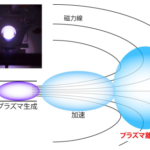2022-12-05 ローレンスリバモア国立研究所(LLNL)
新しい研究では、科学者が、600 GPa(60億気圧)まで動的に圧縮した5つの金属に関する一連のX線回折実験について報告している。研究チームは、複数の圧縮試料の原子構造情報を収集することに加え、準等方的なランプ圧縮下でのX線回折実験に適用できる、圧力決定のための異なるアプローチを実証した。
今回の研究では、共同研究者たちが、動的圧縮下でのX線回折実験における圧力決定の新しいアプローチとして、in-situキャリブレーションを使用することをテストした。この方法は、ダイヤモンドアンビルセルを用いた高圧X線回折測定と同様に、圧力-密度状態方程式がよく知られている物質を圧力計として使用することに依存している。
ロチェスター大学のオメガレーザー施設において、複数の材料(白金、タンタル、金、タングステン、鉄の組み合わせ)を擬似等方経路に沿って数百GPa(数百万気圧)の圧力まで同時に圧縮した。校正物質のX線回折パターンを収集し、同時に速度計測を行うことで、研究チームは2つの圧力決定方法を相互検証しただけでなく、動的ランプ圧縮実験において速度干渉計システム(VISAR)測定に代わる実行可能な方法としてin-situ校正物質の使用を確立することができた。
圧力決定の精度を4倍向上させる新しい機能を提供することに加え、この研究は、過去の動的圧縮実験で広く採用されてきた方法を検証するものであり、動的圧縮実験と静的圧縮実験の間のギャップを縮小することに貢献するものである。
<関連情報>
- https://www.llnl.gov/news/improving-precision-pressure-determination-nanosecond-x-ray-diffraction-experiments
- https://journals.aps.org/prb/abstract/10.1103/PhysRevB.106.134105
ナノ秒X線回折実験における圧力測定の高精度化 X-ray diffraction measurements and pressure determination in nanosecond compression of solids up to 600 GPa
F. Coppari, D. E. Fratanduono, M. Millot, R. G. Kraus, A. Lazicki, J. R. Rygg, R. F. Smith, and J. H. Eggert
Physical Review B Published 14 October 2022
DOI:https://doi.org/10.1103/PhysRevB.106.134105
ABSTRACT
X-ray diffraction measurements under laser-driven dynamic compression now allow us to investigate the atomic structure of matter at TPa pressures and thousands of degree temperatures, with broad implications for condensed matter physics, planetary science, and astronomy. Pressure determination in these experiments often relies on velocimetry measurements coupled with modeling that requires accurate knowledge of the optical and thermomechanical properties of a window material, resulting in significant systematic uncertainty. Here we report on a series of x-ray diffraction experiments on five metals dynamically compressed to 600 GPa. In addition to simultaneously collecting atomic structure information for multiple compressed samples, namely Pt, Ta, Au, W, and Fe, we demonstrate a different approach for pressure determination applicable to x-ray diffraction experiments under quasi-isentropic ramp compression. The method, based on the use of in situ pressure calibrants, is similar to the techniques often adopted in static compression with diamond anvil cells. Focusing on experiments using a diamond window, we discuss challenges and mitigation strategies for the novel approach. Our study provides lattice-level information on five different metals compressed to hundreds of GPa and validation to the currently used methods for pressure determination based on time-resolved measurement of the diamond free-surface velocity, revealing that the use of in situ calibrants enables a factor of four reduction in the pressure uncertainty in these experiments.



